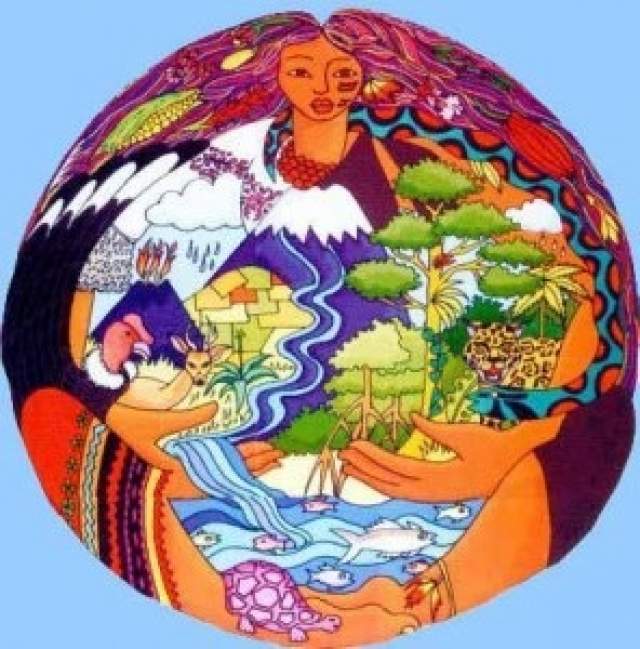Life Centered Alternatives
This domain delves into avenues where human actions are intentionally directed to prioritize not just human rights, but also the rights of more-than-human entities. Unlike traditional resistance movements that are often rooted in political, social, or economic viewpoints, these alternatives emphasize lived experiences and ways of life. A significant portion of the movements and alliances in this realm have been shaped by tapping into and expanding upon age-old wisdom.
Shikshantar
Shikshantar is a school which utilizes an alternative framework when it comes to learning and education. It does not use an exam-oriented form of learning but rather places children at the center of education. The principle underlying Shikshantar is that every child has the capacity to learn. Experiential education is enmeshed in the curriculum and the syllabus is used to facilitate goals and processes. The school is grounded in environmentally conscious practice; it is largely solar powered, recycled materials used for art and learning, and the decrease of single use plastics.
Comunalidad
Communalidad is a framework which is different to Western ideology and Indigenous framework born from the Ayuuk and Zapotec peoples in Oaxaca, and anthropologists to describe the interconnection of people with their environment and centers around four pillars of communal life: 1) communal governance (popular assemblies); 2) communal territory, 3) work for the benefit of the whole; 4) communal celebration. It also critiques language and concepts used to describe land (property, rights, etc) that we inherited from modern Western culture but do not represent Indigenous epistemologies and ontologies. The idea here is that Indigenous cosmovision and stewardship is lived praxis. Comunalidad is a very small localized conversation online. The conversation is largely in Spanish and occurring in Mexico, Spain, Colombia and Chile. The main actors here are academics, civil society members, and activists.
Zapatista
The Zapatista uprising began in 1994, Chiapas México. The Zapatistas derived their name from Emiliano Zapata, a Mexican revolutionary who became renowned for his prominent role in the Mexican Revolution. Zapata, alongside libertarian socialist ideology drawn from Marxismand anarchism,informs the Zapatista Army of National Liberation (EZLN’s) political philosophy of neozapatismo. The Zapatista movement was largely made up Indigenous activists from the Tzotzil, Tzeltal, Tojolab’al, and Ch’ol tribes. What began as a 12 day uprising in protest of the enactment of the North American Free Trade Agreement (representing the recolonization of their country), culminated in the International solidarity Zapatista movement. The Zapatista uprising is credited to a number of systemic modifications in Mexico, such as the state’s democratization. Following the uprising, the citizens continued to advocate for human rights, democracy, healthcare and education. The militarisation of Chiapas increased to 200% in an effort to suppress Indigenous resistance such as the Zapatista uprising. The EZLN set up Rebel Zapatista Autonomous Municipalities in Chiapas, which continue to grow today. In 2003, they introduced five “caracoles,” or organizational regions, and added seven more in 2019. These areas emphasize the establishment of grassroots democratic structures, communal land management, health services, education, and the advancement of women’s rights.
Rojava
The Rojava Movement refers to a socio-political and cultural revolution in the predominantly Kurdish region of Northern Syria. It surfaced during the Syrian Civil War, and Rojava declared its autonomy in 2012. The movement is characterized by its commitment to the ideals of grassroots democracy, gender equality, and ecological sustainability. It draws significant inspiration from the democratic confederalism philosophy of Abdullah Öcalan, which advocates for a decentralized, community-led form of governance and self-determinism. The Rojava Movement has been notable for its efforts to establish a multi-ethnic and inclusive governance structure in the midst of the Syrian conflict, while also championing women’s rights and representation.

Buen Vivir
Buen Vivir or sumak kawsay is set of principles that originated from the Quechua people of the Andes in South America (Abya Yala), in which “the subject of wellbeing is not the individual, but the individual in the social context of their community and in a unique environmental situation” (Gudynas, 2013). It is a way of life in which humans coexist in harmony with nature in order to accomplish a “good way of living.” In practice this means that humans were never owners of the earth or its resources, only stewards, this concept contrasts with the idea of ‘natural capital’ which is widely used in economic and business spaces. A concept more reflective of buen vivir is a sharing economy; a socio-economic system wherein consumers share in the production, creation, distribution and trade of goods and services.
